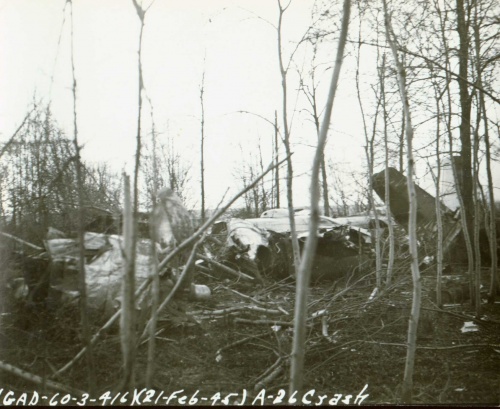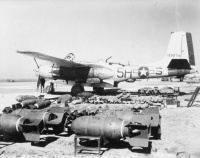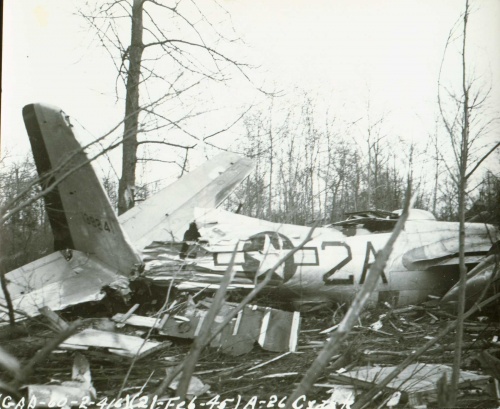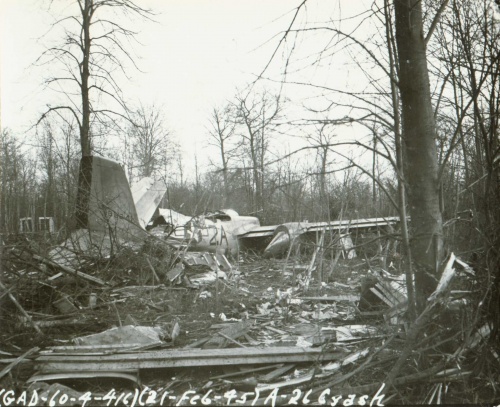41-39241
| A-26B-20 Invader | |||
|---|---|---|---|
| Builders: Douglas Aircraft Company | |||
| Operators: United States Air Force | |||
| Number Built: 153 (99-DL, 54-DT) | |||
| First Built: Jul 1944 | |||
| GENERAL CHARACTERISTICS | |||
| Type: Light Attack Bomber | |||
| Wet Weight: 31,000 lbs | |||
| Length: 50' 9" (with guns) 49' 11" (without guns) | |||
| Height: 18' 6" (5.64 m) | |||
| Wingspan: 70' (21.34 m) | |||
| Wing Area: 540 Sq. Feet (50.17 m²) | |||
| Speed: 212 mph | |||
| Max Speed: 370 mph | |||
| Ceiling: 31,300 feet | |||
| Powerplant: 2x Pratt & Whitney R-2800-27 | |||
| Horsepower: 2,000 each | |||
| Fuel Capacity: 1,600 US Gallons | |||
| Range: | |||
| Crew: 3 | |||
| Passengers: 1 | |||
| ARMAMENT | |||
| Nose Guns: 6x .50 Machine Guns | |||
| Dorsal Turret: 2x .50 Machine Guns | |||
| Ventral Turret: 2x .50 Machine Guns | |||
| Payload: 4,000 lbs internal 2,000 lbs wing points | |||
| Donate | |||
| Donate | |||
| Even a small donation of a couple of dollars goes a long way in helping | |||
See also: List of Invaders by Serial Number
During 1944 this plane was painted with the identification code: 2A-F
Operational History
This plane was assigned to the 669th Bombardment Squadron, 416th Bombardment Group during November 1944. It began participating in combat missions immediately thereafter.
Missions
- Mission # 159 - November 17, 1944, Friday PM Hageunau, France - Supply Depot
Accidents
21 FEB 1945 - This plane was completely destroyed in a landing accident after returning from a combat mission. One engine was shot out and the pilot made an error in the landing procedure causing the plane to crash into pilot housing on the base. 1 pilot on the ground was killed, and 2 others were injured. The pilot of this plane was also injured and the gunner suffered only minor injuries.
Description: A third plane, piloted by Lt. R.K. Johnson of the 669th squadron had an engine shot out. Feathering it, he returned to base on single engine and attempted to land. He didn't think he would make it on the first run, so pulled up, but turned into his dead engine. He had no pulling power, the plane stalled and headed toward the tents in the 670th squadron area. Some pilots were watching the landings, saw Johnson's plane coming toward them, and ran. They did not get clear enough. The plane struck a wooden building. The three pilots hit, being Lt. John Cook, Lt. T.S. "Ted" Merritt and Lt. Stan Sheley. Lt. Cook suffered a fractured skull, hips and legs, causing him to lose his life. Merritt suffered a fractured leg and Sheley had a foot bone broken. Pilot Johnson was trapped in his wreckage for about an hour and was dragged out, suffering a broken collar bone and cuts about the face. His gunner, Sgt. Brandt escaped injury. (Attack Bombers We Need You! A History of the 416th Bomb Group. Ralph Conte, Page 210)
Ted Merritt also had one eyeball hanging out and needed morphine. He had the morphine in his pocket and asked the first guy that arrived to get it out and give him a shot (Our first aide kits in the airplane had morphine in them-some crew members carried some of it on their person for emergencies of which there were many). The hospital put his eye back in and repaired his other broken bones. It took a year. He stayed in the service. He took eye treatments and eye exercises for four years and actually got back on flying status. The photos were taken from the front door of the tent I lived in, in the 670th BS area. My crew and I were out on the flight line at our plane at that time and watched the crash occur. (Wayne Downing, personal correspondence)
A third plane, piloted by Lt R.E. Johnson, returned on a single engine when flak had knocked it out over the target. He came in to land but found that he was not going to make the field. He began to pull up and go around. Turning into his dead engine, the plane refused to climb. It crashed into the woods in the 670th Squadron area and piled through part of a living site. The men in the area, hearing the plane's approach, ran for safety. Three did not get clear of the plane. Lt Cook was killed instantly in his tent. Lieutenants T.S. Merritt and Sheley were struck by the parts of the plane. Lt Merritt suffered a fracture of the leg. Lt Sheley was more fortunate, breaking a small bone in his foot, from which he recovered in a short time. The fuselage bent double at about the middle of the bomb-bay. Lt Johnson's body was flung out of the cockpit into one of the wheel housings. It required 45 minutes for medical officers to free him from the wreckage. He suffered a broken collar bone and minor facial injuries. He has been evacuated to a hospital in another zone of operations. His gunner, Sgt Brandt, crawled from the wreckage uninjured except for shock. He was treated immediately with no further ill effects from the accident. (416th BG History 1945)
After successfully attacking the Lage railroad bridge in Germany, the aircraft piloted by Lt. R.K. Johnson, was hit by anti-aircraft artillery fire. It was necessary for Lt. Johnson to feather the left propeller of the airplane and proceed back to the base on a single engine. While attempting to land, another aircraft flew in front of the disabled plane. The pilot tried to go around for another landing attempt, but the aircraft swerved to the left and crashed in a wooded section of the 670th Bombardment Squadron's area. The crashing airplane destroyed one officer's billet and damaged two others. Lt. Cook, of the 670th died as a result of injuries sustained, while Lt. Merritt and Lt. Sheley, of the same organization, sustained a broken leg and a broken foot respectively.
The gunner of the aircraft, Sgt. Brandt, escaped with minor injuries. Lt. Johnson was pinned beneath the wreckage for approximately one hour. (Fortunately there was no fire.) When he was finally extricated, it was found that he had suffered a broken collar bone and injuries to his face. ("669th Bombardment Squadron (L) History")
General Orders No. 54, 7 April 1945, Purple Heart is awarded to: 669th Bombardment Squadron (L), Robert K. Johnson, O-765256, Second Lieutenant, Air Corps, United States Army. For wounds received as a result of enemy action on 21 February 1945, while serving as Pilot on an A-26 airplane on a combat operational mission over enemy occupied territory. Entered military service from Seattle, Washington.
General Orders No. 54, 7 April 1945, Purple Heart is awarded to: 669th Bombardment Squadron (L), Henry E. Brandt, 36593012, Sergeant, Air Corps, United States Army. For wounds received as a result of enemy action on 21 February 1945, while serving as Gunner on an A-26 airplane on a combat operational mission over enemy occupied territory. Entered military service from Detroit, Mich. (416th BG Purple Heart Awards (PDF))
See Mission # 209 for additional details
Known Crew
- Lt. W. F. Tripp - Pilot
- SSgt D. F. Mallory - Gunner
- Lt. Robert K. Johnson - Pilot
- Sgt. Henry E. Brandt - Gunner
Disposition
Destroyed in landing accident 21 Feb 1945.
Images
Images from the crash on 21 FEB 1945. Photos from the Captain Francis J. Cachat Collection.

References
- Air Force Accident Reports
- MACR
- 416th Bomb Group Unit History






